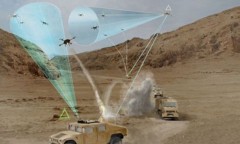By Arthur Dominic J. Villasanta , | April 23, 2017

Titan Cray XK7 supercomputer. the most powerful in the U.S.
The U.S. Defense Advanced Research Projects Agency (DARPA) has a weird project in which it wants to develop a "semantic engine" that can make sense of the world by combining disparate and diffuse bits of information into a more understandable single picture.
DARPA said the goal of its new program called AIDA (Active Interpretation of Disparate Alternatives) is "to develop a multihypothesis semantic engine that generates explicit alternative interpretations of events, situations, and trends from a variety of unstructured sources, for use in noisy, conflicting, and potentially deceptive information environments."
Like Us on Facebook
DARPA requires that this engine and its algorithms (basically a decision-making tool) must be capable of mapping knowledge elements automatically derived from multiple media sources into a common semantic representation, aggregating information derived from those sources, and generating and exploring multiple hypotheses about the events, situations, and trends of interest."
More importantly, this engine must establish confidence measures for the derived knowledge and hypotheses, based on the accuracy of the analysis and the coherence of the semantic representation of each hypothesis.
This engine "must also be capable of utilizing knowledge in the common semantic representation and the generated hypotheses as alternate contexts for the media analysis algorithms by altering their models or prior probabilities to enhance accuracy and resolve ambiguities in line with expectations from the context. "
In addition, the engine must be able to communicate with its user to reveal the generated hypotheses, and to allow the user to alter the hypotheses or to suggest new ones.
"It is a challenge for those who strive to achieve and maintain an understanding of world affairs that information from each medium is often analyzed independently, without the context provided by information from other media," said Boyan Onyshkevych, a program manager in DARPA's Information Innovation Office.
"Often, each independent analysis results in only one interpretation, with alternate interpretations eliminated due to lack of evidence even in the absence of evidence that would contradict those alternatives. When these independent, impoverished analyses are combined, generally late in the analysis process, the result can be a single apparent consensus view that does not reflect a true consensus."
-
Use of Coronavirus Pandemic Drones Raises Privacy Concerns: Drones Spread Fear, Local Officials Say

-
Coronavirus Hampers The Delivery Of Lockheed Martin F-35 Stealth Fighters For 2020

-
Instagram Speeds Up Plans to Add Account Memorialization Feature Due to COVID-19 Deaths

-
NASA: Perseverance Plans to Bring 'Mars Rock' to Earth in 2031

-
600 Dead And 3,000 In The Hospital as Iranians Believed Drinking High-Concentrations of Alcohol Can Cure The Coronavirus

-
600 Dead And 3,000 In The Hospital as Iranians Believed Drinking High-Concentrations of Alcohol Can Cure The Coronavirus

-
COVID-19: Doctors, Nurses Use Virtual Reality to Learn New Skills in Treating Coronavirus Patients










